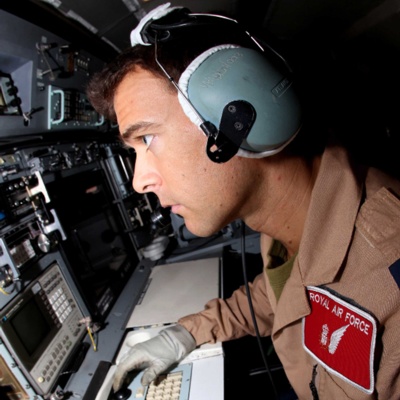About the RC-135W Rivet Joint
ROLE
RC-135W Rivet Joint is a dedicated electronic surveillance aircraft that can be employed in all theatres on strategic and tactical missions. Its sensors ‘soak up’ electronic emissions from communications, radar and other systems.
CAPABILITY
RC-135W Rivet Joint employs multidiscipline Weapons System Officer (WSO) and Weapons System Operator (WSOp) specialists whose mission is to survey elements of the electromagnetic spectrum in order to derive intelligence for commanders.

Image by: Sgt Neil Bryden
TYPE HISTORY
When it flew its Model 367-80 ‘Dash 80’ prototype for the first time on July 15, 1954, Boeing hoped the aircraft would take the airlines by storm. Extrapolating technology used on the B-47 and B-52 jet bombers, the aircraft represented a quantum leap directly into the jet age compared to the company’s piston-engined Model 367 Stratocruiser. With its swept wing and fourjet powerplant, carried in discrete underwing nacelles, the Dash 80 was the most modern commercial transport available.
Yet the airlines were left unimpressed and it was the US Air Force, realising it needed a jet tanker to support its jet bombers, that saw the Dash 80 into production. In September 1955 it ordered its first KC-135A Stratotanker, Boeing modifying the Dash 80 to trial a ‘flying boom’ refuelling system. The Stratotanker entered service on June 28, 1957 and Boeing continued development along this military line under the company designation Model 717.
The airlines had been unimpressed by the Dash 80’s cabin width, which was too narrow for six-abreast seating, and Boeing therefore returned to the Dash 80 concept, widening the cabin and developing a series of successful airliners as the Model 707.
Boeing built 732 KC-135s in different variants, many of them ultimately re-engined with the modern CFM56 turbofan, known as the F108 in military service. These aircraft are designated KC-135R. There was also a line of C-135 transports, EC-135 command posts, RC-135 intelligence gatherers and a host of other variants, with the KC and RC remaining in widespread service.
Developed under Boeing’s Model 739 series, the first of a long line of RC-135 variants was ordered in 1962. This photographic reconnaissance RC-135A entered service during the mid-1960s, followed by the first of the electronic intelligence gatherers, the RC-135B. The precedent for modifying KC airframes to RC standard was set in 1972, with the conversion of three KC-135As as RC-135Ds for the Rivet Brass mission. All subsequent RC variants were produced by conversion/upgrade, mostly from C, KC and RC standards, culminating in the RC-135V and RC-135W, operated under the Rivet Joint codename that has become internationally, and officially recognised in USAF parlance, as the type’s name.
In June 2011, 51 Sqn flew the final BAe Nimrod R.Mk 1 sortie of its 37-year association with the type. Plans were under way for the aircraft’s replacement under a project known as Airseeker, which had begun the previous March. It envisaged the acquisition of three RC-135W Rivet Joint aircraft for delivery from 2013. The machines were to be converted from USAF KC-135R airframes and L-3 Communications in Greenville, Texas was chosen to perform the work as the USAF’s experienced Rivet Joint contractor. The work began in March 2011.
On November 12, 2013, No. 51 Sqn took delivery of the UK’s first Rivet Joint, operating its maiden operational sortie on May 23, 2014. The second aircraft arrived in August 2015 and the third on June 8, 2017. For the purposes of sensor and system upgrades, the trio are considered an extension of the USAF Rivet Joint fleet, ensuring they remain at the cutting edge of capability.
Rivet Joint has been deployed extensively for Operation Shader and on other operational taskings. It had been formally named Airseeker, but is almost universally known in service as the RC-135W Rivet Joint.
Header image by Sgt Si Pugsley
Specifications
RC-135W Rivet Joint:
- Powerplant: four 21,600lb st (96kN) CFM International F108-CF-201 turbofan engines
- Length: 135ft (41.10m)
- Height: 42ft (12.80m)
- Wingspan: 131ft (39.90m)
- Wing area: 2,433sqft (226.03m2)
- Maximum take-off weight: around 297,000lb (133,633kg)
- Maximum airspeed: 470kt (870km/h)
- Range: around 3,900 miles (6,500km)
- Service ceiling: 39,000ft
- Crew: 2 pilots, 1 navigator and a Mission Crew configured for the task.










